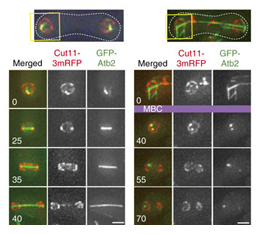Research Abstract
極間微小管は分裂酵母の減数第二分裂には必要でない
Interpolar microtubules are dispensable in fission yeast meiosis II
2012年2月28日 Nature Communications 3 : 695 doi: 10.1038/ncomms1725

紡錘体は2種類の微小管からなる。動的な動原体微小管は動原体を捕捉しているが、極間微小管は安定で、2つの紡錘体極を連結する構造上の支柱として働いている。これらの微小管は共に、真核細胞の細胞分裂に不可欠であると考えられてきた。本論文では、極間微小管は、分裂酵母の減数第二分裂には必要ないことを示す。極間微小管が微小管脱重合薬によって破壊された場合でも、ほとんどの接合子で、減数第二分裂の際には紡錘体極は分離し、染色体は極方向に分離されて、生存可能な胞子が形成される。これらの事象が極間微小管が存在しない状況で起きるのは、減数第二分裂の際に核を包みこみ、膜先導領域(leading edge)を構築するタンパク質群とセプチンによって伸長が誘導される前胞子膜によるものである。また、微小管に人工処理を施さない生理的な減数第二分裂の際には、前胞子膜の形成が紡錘体の分離と核の分裂を構造的に引き起こしており、それらの事象を起こすのに十分な力を極間微小管とは無関係に生み出している。
- 東京大学大学院 理学系研究科 生物化学専攻
- 科学技術振興機構(JST)戦略的創造研究推進事業(PRESTO)
- かずさDNA研究所
The mitotic spindle consists of two types of microtubules. Dynamic kinetochore microtubules capture kinetochores, whereas stable interpolar microtubules serve as the structural backbone that connects the two spindle poles. Both have been believed to be indispensable for cell division in eukaryotes. Here we demonstrate that interpolar microtubules are dispensable for the second division of meiosis in fission yeast. Even when interpolar microtubules are disrupted by a microtubule-depolymerizing drug, spindle poles separate and chromosomes segregate poleward in second division of meiosis in most zygotes, producing viable spores. The forespore membrane, which encapsulates the nucleus in second division of meiosis and is guided by septins and the leading-edge proteins, is responsible for carrying out meiotic events in the absence of interpolar microtubules. Furthermore, during physiological second division of meiosis without microtubule perturbation, the forespore membrane assembly contributes structurally to spindle pole separation and nuclear division, generating sufficient force for spindle pole separation and subsequent events independently of interpolar microtubules.

